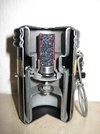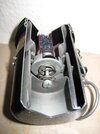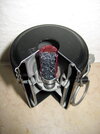Cutaway model of a Czech RG-4 offensive handgrenade. It is made completely out of pressed sheet steel, and functions according to the “allways fuze“ principle, where -in this case- two containers of explosives form the weights for the allways fuze. No pyrotechnic fuze is used in this handgrenade and the shock of impact only will instantaniously detonate this handgrenade, regardless of the grenade landing on top, bottom, sideways or under any random agle (pict 04). The sensitive stab detonator is placed in the upper explosive container, the firing pin (red) is placed upon the lower explosives container.
The outer body of the grenade has two radial placed slots at 90 degrees each (pict 02); the first slot houses a fork that fits around the firing pin and has the function to keep both explosives cilinders separeted and fixated when the grenade is safe. The second slot houses a spoon that masks the sensitive stab detonator from the firing pin. Connected to the spoon is a brass ribbon that is wound around the grenade body three times and has a lead weight at the end. Both -the fork and the lead weight at the end of the brass ribbon- are fixated by means of a longitudaly placed pin with a pull ring.
Before throwing the grenade one holds the grenade in such a way that the thumb presses on the lead weight.When one puls the pin down with the pull ring this allows the fork to be pulled out of the grenade, however the thumb on the lead weight prevents the brass ribbon from unwinding. As soon as the grenade is thrown, the brass ribbon unwinds, falls away from the grenade, and pulls the spoon out of the grenade body. The grenade is now armed -during/in flight- (pict 03) and the firing pin is kept away from the stab detonator only by means of the creep spring seperating both. Upon impact the firing pin and stab detonator move towards one another, igniting the stab detonator, detonating the grenade.
To change the RG 4 from an offensive to a defensive grenade a steel sleeve that fits around the lower granade body ia available.
It is needless to say that this grenade must have resulted in a number of duds, especially when used in high grass or soft snow as the force of the impact is muffled, resulting in a too soft landing to activate the fuze.
The RG-4 is the post war improved version of the WW2 Czech RG34.
Overall length : 84mm
Diameter : (upper ridge 57mm , body 53mm
Weight : 322 grams
Explosive charge : 110 grams TNT
Lethal radius : 5 to 10 meters
Regards, DJH
The outer body of the grenade has two radial placed slots at 90 degrees each (pict 02); the first slot houses a fork that fits around the firing pin and has the function to keep both explosives cilinders separeted and fixated when the grenade is safe. The second slot houses a spoon that masks the sensitive stab detonator from the firing pin. Connected to the spoon is a brass ribbon that is wound around the grenade body three times and has a lead weight at the end. Both -the fork and the lead weight at the end of the brass ribbon- are fixated by means of a longitudaly placed pin with a pull ring.
Before throwing the grenade one holds the grenade in such a way that the thumb presses on the lead weight.When one puls the pin down with the pull ring this allows the fork to be pulled out of the grenade, however the thumb on the lead weight prevents the brass ribbon from unwinding. As soon as the grenade is thrown, the brass ribbon unwinds, falls away from the grenade, and pulls the spoon out of the grenade body. The grenade is now armed -during/in flight- (pict 03) and the firing pin is kept away from the stab detonator only by means of the creep spring seperating both. Upon impact the firing pin and stab detonator move towards one another, igniting the stab detonator, detonating the grenade.
To change the RG 4 from an offensive to a defensive grenade a steel sleeve that fits around the lower granade body ia available.
It is needless to say that this grenade must have resulted in a number of duds, especially when used in high grass or soft snow as the force of the impact is muffled, resulting in a too soft landing to activate the fuze.
The RG-4 is the post war improved version of the WW2 Czech RG34.
Overall length : 84mm
Diameter : (upper ridge 57mm , body 53mm
Weight : 322 grams
Explosive charge : 110 grams TNT
Lethal radius : 5 to 10 meters
Regards, DJH






